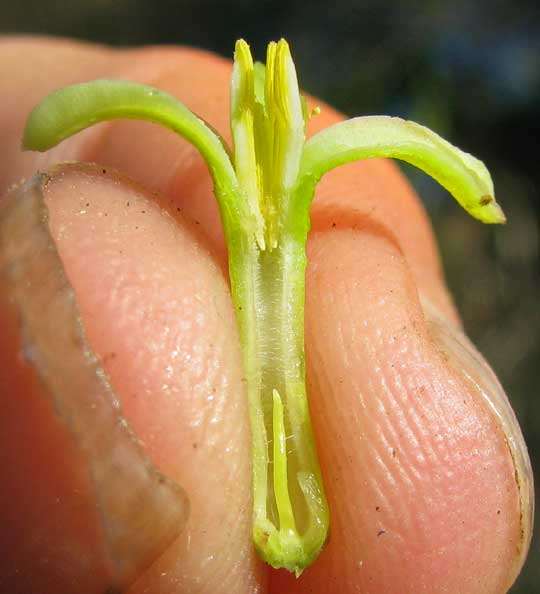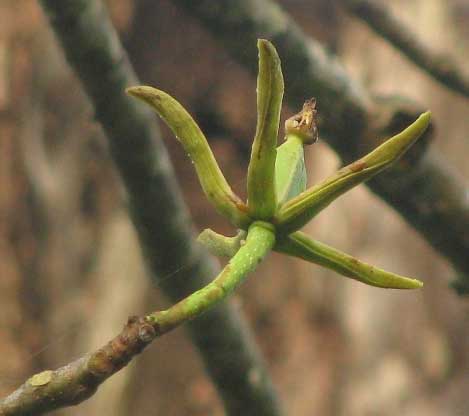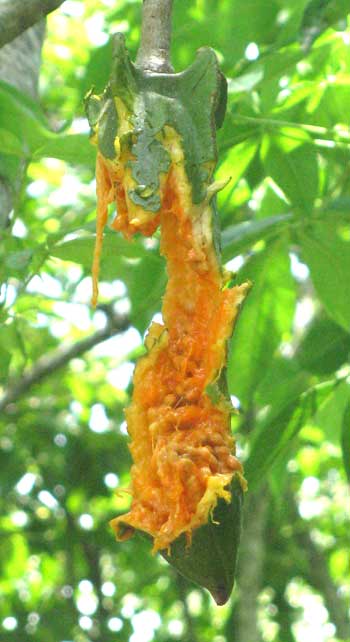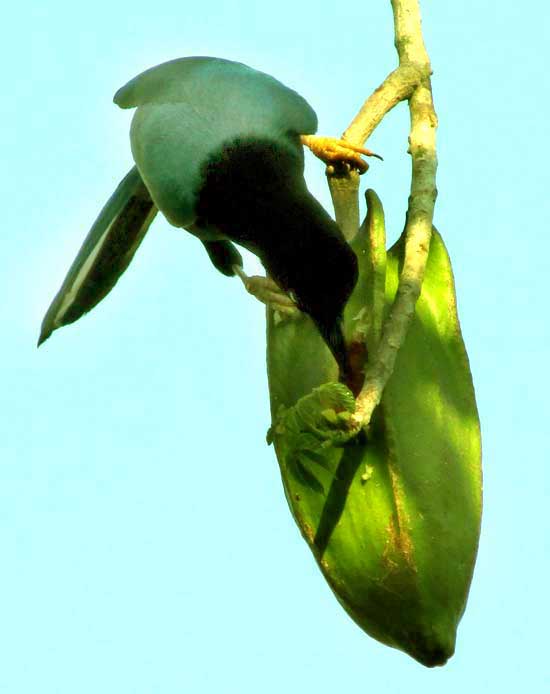Excerpts from Jim Conrad's
Naturalist Newsletter
 from the February 7, 2010 Newsletter issued from Hacienda Chichen Resort beside Chichén Itzá Ruins; limestone bedrock; elevation ~39m (~128ft), N20.675°, W88.569°; central Yucatán state, MÉXICO
from the February 7, 2010 Newsletter issued from Hacienda Chichen Resort beside Chichén Itzá Ruins; limestone bedrock; elevation ~39m (~128ft), N20.675°, W88.569°; central Yucatán state, MÉXICO
JACARATIAS FLOWERING
One of the strangest-looking trees nowadays is one that's lost all its leaves for the dry season, and possesses a gray, smooth trunk swollen so out of proportion to its branching system that it looks like a little fruit tree sprouting from a gigantic elephant's leg. The local Maya call it Bonete, though I've read that in northwestern Yucatan they call it Ch'iich'puut. I find no English name for it. It's JACARATIA MEXICANA, endemic but frequent in the Mexican states of Yucatán and Campeche, and growing to about 40 feet high (12 m). It's a member of the Papaya Family, the Caricceae.
Vegetation obscures all our Jacaratias' weird trunks but in 2006 near Telchac Pueblo at this time of year I photographed a tree with its trunk completely exposed and you can see it, with a Tropical Mockingbird singing his heart out in it, at the right.
Our trees are flowering now. You can see a hand-size panicle of flowers, mostly not yet open, below:

A cross section of one of those thumbnail-size flowers is shown below:

The unusual thing about that blossom is that its pollen-producing anthers -- the erect, slit-faced items in the flower's center, at its throat -- are very well developed, though they lack the stems, or filaments, of normal anthers. Also, down at the bottom of the corolla tube where you'd expect a plump ovary to reside, there's just a fingerlike thing looking like it could never develop into a fruit. Of course this is a unisexual male flower, for Jacaratias come in male and female trees (the trees are dioecious) and that fingerlike thing is just a sterile, vestigial ovary. This flower looks very much like a male Papaya flower, one of which you can see on the right at www.backyardnature.net/yucatan/papaya3.jpg.
Jacaratia's female flowers, in contrast, are much larger than the Papaya's female flower shown on the left in the above picture. You can see a female Jacaratia flower with its oversize, brown stigmas:

In the above picture notice how this female flower's ovary bears longitudinal ridges. Those ridges will develop into "fins" on a torpedo-like fruit, as shown below:

The fruit gets to about six inches long (15 cm) and may yellow. The local Maya eat it raw, saying that it's sweet enough as it is.
The tree's leaves, which will return with the rains but which now are completely absent, cluster toward the tips of branches and are "palmately compound" -- consist of five to seven slender leaflets arising from atop a stem, or petiole, like fingers from the palm of a hand. They look rather like a Schefflera's compound leaves, if you know that potted plant up North.
from the January 31, 2010 Newsletter issued from Hacienda Chichen Resort beside Chichén Itzá Ruins, central Yucatán, MÉXICO; limestone bedrock, elevation ~39m (~128ft), ~N20.676°, ~W88.569°
JACARATIAS FRUITING
Now that the fruits have been maturing for half a year, with me expecting them to ripen and fall at any time, I see that all along I've entertained a faulty concept of how the fruits eventually would fall and their seeds would get disseminated. Pointed toward the ground and with those swooped-back fins I'd assumed that one day the ripe, orangish fruit would dislodge from the stem and plummet to the ground, maybe stabilized during its fall by its fins, then might even lodge nose-down in the rainy season's mud. But, below, you can see the fruit's final destiny:

The fruit, still green outside but orangish like ripe papaya inside, remains on the tree while animals eat them in situ. Birds, certainly, but also I suspect fruit bats eat them and probably Kinkajous, who nightly ravish our mango trees without permitting me to photograph them.
My friend José confirms that the fruits don't fall by themselves. "Use a pole," he advises.
from the May 29, 2016 Newsletter issued from Hacienda Chichen Resort beside Chichén Itzá Ruins; limestone bedrock; elevation ~39m (~128ft), N20.675°, W88.569°; central Yucatán state, MÉXICO
GREEN JAY EATING JACARATIA FRUIT
Behind the hut, both the Spanish Plum and the Jacaratia -- what the Maya call Bonete -- are producing ripe fruit, which birds eat before I can. You can see a Green Jay feeding on a Jacaratia fruit below:

Earlier I theorized that the "fins" atop the Jacaratia fruit enable birds, bats and other fruit lovers to more securely hang onto the fruit as they feed on it below them. Our Green Jay has at least one foot on a fin as he reaches down to probe the hole that sometimes also serves other birds, especially White-fronted Parrots.
Our earlier entry shows a half-devoured ripe fruit that, I write, had been maturing for half a year. The picture was taken here in January, 2010. I'm sure that some of our May Jacaratia fruits are mature, because messy parrots drop pieces of fruit flesh into my wash basin exactly below the tree. Last week I tried to knock down with a pole the very fruit the Green Jay is feeding on, but you see who gets to eat that fruit.